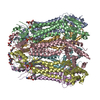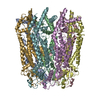+ データを開く
データを開く
- 基本情報
基本情報
| 登録情報 | データベース: PDB / ID: 8gts | ||||||
|---|---|---|---|---|---|---|---|
| タイトル | CryoEM structure of human Pannexin1 with R217H congenital mutation. | ||||||
 要素 要素 | Pannexin-1 | ||||||
 キーワード キーワード | MEMBRANE PROTEIN / Pannexin1 / ATP release / large-pore ion channel | ||||||
| 機能・相同性 |  機能・相同性情報 機能・相同性情報ATP transmembrane transporter activity / ATP transport / leak channel activity / Electric Transmission Across Gap Junctions / positive regulation of interleukin-1 alpha production / wide pore channel activity / bleb / monoatomic anion transmembrane transport / gap junction / monoatomic anion channel activity ...ATP transmembrane transporter activity / ATP transport / leak channel activity / Electric Transmission Across Gap Junctions / positive regulation of interleukin-1 alpha production / wide pore channel activity / bleb / monoatomic anion transmembrane transport / gap junction / monoatomic anion channel activity / gap junction channel activity / positive regulation of macrophage cytokine production / Mechanical load activates signaling by PIEZO1 and integrins in osteocytes / oogenesis / response to ATP / The NLRP3 inflammasome / monoatomic cation transport / positive regulation of interleukin-1 beta production / response to ischemia / calcium channel activity / calcium ion transport / actin filament binding / cell-cell signaling / protease binding / High laminar flow shear stress activates signaling by PIEZO1 and PECAM1:CDH5:KDR in endothelial cells / scaffold protein binding / transmembrane transporter binding / signaling receptor binding / endoplasmic reticulum membrane / structural molecule activity / endoplasmic reticulum / protein-containing complex / identical protein binding / membrane / plasma membrane 類似検索 - 分子機能 | ||||||
| 生物種 |  Homo sapiens (ヒト) Homo sapiens (ヒト) | ||||||
| 手法 | 電子顕微鏡法 / 単粒子再構成法 / クライオ電子顕微鏡法 / 解像度: 3.87 Å | ||||||
 データ登録者 データ登録者 | Hussain, N. / Penmatsa, A. | ||||||
| 資金援助 |  インド, 1件 インド, 1件
| ||||||
 引用 引用 |  ジャーナル: Nat Commun / 年: 2024 ジャーナル: Nat Commun / 年: 2024タイトル: Cryo-EM structures of pannexin 1 and 3 reveal differences among pannexin isoforms. 著者: Nazia Hussain / Ashish Apotikar / Shabareesh Pidathala / Sourajit Mukherjee / Ananth Prasad Burada / Sujit Kumar Sikdar / Kutti R Vinothkumar / Aravind Penmatsa /   要旨: Pannexins are single-membrane large-pore channels that release ions and ATP upon activation. Three isoforms of pannexins 1, 2, and 3, perform diverse cellular roles and differ in their pore lining ...Pannexins are single-membrane large-pore channels that release ions and ATP upon activation. Three isoforms of pannexins 1, 2, and 3, perform diverse cellular roles and differ in their pore lining residues. In this study, we report the cryo-EM structure of pannexin 3 at 3.9 Å and analyze its structural differences with pannexin isoforms 1 and 2. The pannexin 3 vestibule has two distinct chambers and a wider pore radius in comparison to pannexins 1 and 2. We further report two cryo-EM structures of pannexin 1, with pore substitutions W74R/R75D that mimic the pore lining residues of pannexin 2 and a germline mutant of pannexin 1, R217H at resolutions of 3.2 Å and 3.9 Å, respectively. Substitution of cationic residues in the vestibule of pannexin 1 results in reduced ATP interaction propensities to the channel. The germline mutant R217H in transmembrane helix 3 (TM3), leads to a partially constricted pore, reduced ATP interaction and weakened voltage sensitivity. The study compares the three pannexin isoform structures, the effects of substitutions of pore and vestibule-lining residues and allosteric effects of a pathological substitution on channel structure and function thereby enhancing our understanding of this vital group of ATP-release channels. | ||||||
| 履歴 |
|
- 構造の表示
構造の表示
| 構造ビューア | 分子:  Molmil Molmil Jmol/JSmol Jmol/JSmol |
|---|
- ダウンロードとリンク
ダウンロードとリンク
- ダウンロード
ダウンロード
| PDBx/mmCIF形式 |  8gts.cif.gz 8gts.cif.gz | 351.5 KB | 表示 |  PDBx/mmCIF形式 PDBx/mmCIF形式 |
|---|---|---|---|---|
| PDB形式 |  pdb8gts.ent.gz pdb8gts.ent.gz | 283.5 KB | 表示 |  PDB形式 PDB形式 |
| PDBx/mmJSON形式 |  8gts.json.gz 8gts.json.gz | ツリー表示 |  PDBx/mmJSON形式 PDBx/mmJSON形式 | |
| その他 |  その他のダウンロード その他のダウンロード |
-検証レポート
| 文書・要旨 |  8gts_validation.pdf.gz 8gts_validation.pdf.gz | 1.5 MB | 表示 |  wwPDB検証レポート wwPDB検証レポート |
|---|---|---|---|---|
| 文書・詳細版 |  8gts_full_validation.pdf.gz 8gts_full_validation.pdf.gz | 1.5 MB | 表示 | |
| XML形式データ |  8gts_validation.xml.gz 8gts_validation.xml.gz | 67.8 KB | 表示 | |
| CIF形式データ |  8gts_validation.cif.gz 8gts_validation.cif.gz | 93.5 KB | 表示 | |
| アーカイブディレクトリ |  https://data.pdbj.org/pub/pdb/validation_reports/gt/8gts https://data.pdbj.org/pub/pdb/validation_reports/gt/8gts ftp://data.pdbj.org/pub/pdb/validation_reports/gt/8gts ftp://data.pdbj.org/pub/pdb/validation_reports/gt/8gts | HTTPS FTP |
-関連構造データ
| 関連構造データ |  34266MC  8gtrC  8gttC M: このデータのモデリングに利用したマップデータ C: 同じ文献を引用 ( |
|---|---|
| 類似構造データ | 類似検索 - 機能・相同性  F&H 検索 F&H 検索 |
- リンク
リンク
- 集合体
集合体
| 登録構造単位 | 
|
|---|---|
| 1 |
|
- 要素
要素
| #1: タンパク質 | 分子量: 48074.816 Da / 分子数: 7 / 変異: R217H / 由来タイプ: 組換発現 / 由来: (組換発現)  Homo sapiens (ヒト) / 遺伝子: PANX1, MRS1, UNQ2529/PRO6028 / 細胞株 (発現宿主): HEK293S / 発現宿主: Homo sapiens (ヒト) / 遺伝子: PANX1, MRS1, UNQ2529/PRO6028 / 細胞株 (発現宿主): HEK293S / 発現宿主:  Homo sapiens (ヒト) / 参照: UniProt: Q96RD7 Homo sapiens (ヒト) / 参照: UniProt: Q96RD7Has protein modification | Y | |
|---|
-実験情報
-実験
| 実験 | 手法: 電子顕微鏡法 |
|---|---|
| EM実験 | 試料の集合状態: PARTICLE / 3次元再構成法: 単粒子再構成法 |
- 試料調製
試料調製
| 構成要素 | 名称: Pannexin 1 (R217H) / タイプ: ORGANELLE OR CELLULAR COMPONENT 詳細: human isoform 1 of Pannexin. Expressed in plasma membranes involved in ATP release Entity ID: all / 由来: RECOMBINANT | |||||||||||||||||||||||||
|---|---|---|---|---|---|---|---|---|---|---|---|---|---|---|---|---|---|---|---|---|---|---|---|---|---|---|
| 分子量 | 値: 48 kDa/nm / 実験値: NO | |||||||||||||||||||||||||
| 由来(天然) | 生物種:  Homo sapiens (ヒト) Homo sapiens (ヒト) | |||||||||||||||||||||||||
| 由来(組換発現) | 生物種:  Homo sapiens (ヒト) / 細胞: HEK293S / プラスミド: pEG Bacmam Homo sapiens (ヒト) / 細胞: HEK293S / プラスミド: pEG Bacmam | |||||||||||||||||||||||||
| 緩衝液 | pH: 8 詳細: Fresh solution containing detergent was prepared for every prep. | |||||||||||||||||||||||||
| 緩衝液成分 |
| |||||||||||||||||||||||||
| 試料 | 濃度: 2.5 mg/ml / 包埋: NO / シャドウイング: NO / 染色: NO / 凍結: YES / 詳細: Sample is homoheptamer purified to homogeneity. | |||||||||||||||||||||||||
| 試料支持 | 詳細: 25 milli amps for 60s / グリッドの材料: GOLD / グリッドのサイズ: 300 divisions/in. / グリッドのタイプ: Quantifoil R1.2/1.3 | |||||||||||||||||||||||||
| 急速凍結 | 装置: FEI VITROBOT MARK IV / 凍結剤: ETHANE / 湿度: 100 % / 凍結前の試料温度: 288 K 詳細: sequentially blotted for 2 and 3.5 seconds with a wait of 10 s. |
- 電子顕微鏡撮影
電子顕微鏡撮影
| 実験機器 |  モデル: Titan Krios / 画像提供: FEI Company |
|---|---|
| 顕微鏡 | モデル: FEI TITAN KRIOS |
| 電子銃 | 電子線源:  FIELD EMISSION GUN / 加速電圧: 300 kV / 照射モード: OTHER FIELD EMISSION GUN / 加速電圧: 300 kV / 照射モード: OTHER |
| 電子レンズ | モード: OTHER / 倍率(公称値): 130000 X / 最大 デフォーカス(公称値): 3300 nm / 最小 デフォーカス(公称値): 1800 nm / Cs: 2.7 mm / アライメント法: COMA FREE |
| 試料ホルダ | 凍結剤: NITROGEN 試料ホルダーモデル: FEI TITAN KRIOS AUTOGRID HOLDER 最高温度: 100 K / 最低温度: 100 K |
| 撮影 | 電子線照射量: 41.12 e/Å2 / 検出モード: COUNTING フィルム・検出器のモデル: GATAN K2 QUANTUM (4k x 4k) 撮影したグリッド数: 1 / 実像数: 1776 |
| 電子光学装置 | エネルギーフィルター名称: GIF Bioquantum / 色収差補正装置: None / 詳細: Bioquantum with K2 camera / エネルギーフィルタースリット幅: 20 eV / 位相板: OTHER / 球面収差補正装置: None |
| 画像スキャン | 動画フレーム数/画像: 40 / 利用したフレーム数/画像: 1-40 |
- 解析
解析
| EMソフトウェア |
| ||||||||||||||||||||||||||||||||||||||||
|---|---|---|---|---|---|---|---|---|---|---|---|---|---|---|---|---|---|---|---|---|---|---|---|---|---|---|---|---|---|---|---|---|---|---|---|---|---|---|---|---|---|
| 画像処理 | 詳細: Images were screened for ice thickness | ||||||||||||||||||||||||||||||||||||||||
| CTF補正 | タイプ: PHASE FLIPPING AND AMPLITUDE CORRECTION | ||||||||||||||||||||||||||||||||||||||||
| 粒子像の選択 | 選択した粒子像数: 781859 / 詳細: selected through particle picking | ||||||||||||||||||||||||||||||||||||||||
| 対称性 | 点対称性: C7 (7回回転対称) | ||||||||||||||||||||||||||||||||||||||||
| 3次元再構成 | 解像度: 3.87 Å / 解像度の算出法: FSC 0.143 CUT-OFF / 粒子像の数: 40873 / クラス平均像の数: 5 / 対称性のタイプ: POINT | ||||||||||||||||||||||||||||||||||||||||
| 原子モデル構築 | B value: 156 / プロトコル: AB INITIO MODEL / 空間: REAL / Target criteria: Correlation coeficient | ||||||||||||||||||||||||||||||||||||||||
| 原子モデル構築 | PDB-ID: 6WBF PDB chain-ID: A / Accession code: 6WBF / Source name: PDB / タイプ: experimental model |
 ムービー
ムービー コントローラー
コントローラー






 PDBj
PDBj







